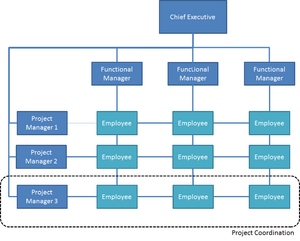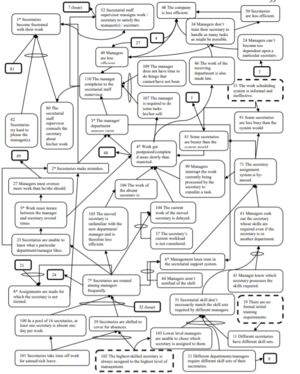Multiple Project Management: Summary, Theory and Improvement
Written by Morten Dam Laursen
Contents |
Abstract
Multiple Project Management (MPM) is, as the name implies, the activity of handling several projects at once. MPM is a concept, which is very important to focus on in companies and organizations, who employ project managers, that are in charge of multiple projects, that are not interrelated or dependent on each other. As Project Management (PM) has become a science itself, so has MPM, as it addresses a number of the same issues. Where PM deals with managing the resources within a specific project, MPM deals with managing several projects, using the same resources (people, facilities etc) as that can be quite complex. MPM differs from portfolio management in the way that it does not concern itself with the management of a portfolio, but rather situations where projects managers are managing several projects at once.
When analyzing companies/organizations with MPM issues, the issues are often of an organizational nature. Without proper MPM proper resource allocation to different projects can often become a big issue and nuisance project managers. While handling several projects at once is very common for many different organizations, it has not been researched much, even though it is considered very relevant and can possibly save on cost, reduce deadlines and loss [1]. This is especially the case in R&D departments, where several different projects are often being carried out simultaneously, using the same people and resources, but with different deadlines and stakeholders. This can often prove difficult for the R&D manager to balance and thus the need for proper Multiple Project Management tools and theories is evident. Many companies have tried to solve these challenges by using standard PM tools. This has proven to be ineffective as many of these do not take into consideration, that several projects will be ongoing parallel [2].
This article will thus describe the typical root causes of problems that arise when dealing with multiple projects, as well as some of the most essential tools that can be used to structure and analyze them. Additionally an annotated bibliography is included with other tools, methods and theories that could be relevant to look into, when dealing with MPM.
Definition
Multiple Project Management occurs many differerent organizations, every single day. As most companies do not have specific departments dedicated to specific projects, they will often have to share the resources they use. This can be in terms of manpower, materials, facilities etc. As this is a daily occurrence in alot of places, it is crucial that companies and organizations learn to properly deal with this, as to avoid some of the issues and problems, that could arise. Project management literature often assumes that the project is a single entity, isolated from other projects, while in reality a project manager can often be the manager of several projects, and have several employees dedicated to more than one project. This defeats the assumption of isolation, as the people involved will thus have to prioritize their time across the projects. In essence this means that MPM can provide companies with a more realistic approach to dealing with the distribution of resources and workload. Generally the elements, which contribute to problems, are: Capacity, Complexity, Conflict, Commitment and Context [3]. Capacity refers to the available resources within the company. It evaluates whether or not the company dedicates an appropriate amount of resources to the projects that it wants completed. Many companies face issues with this, as management tends to launch more projects, than what can realistically be carried out within the right timeline with the available resources.
Conflicts generally stem from one of the following three types of issues: People, systems or organizational. People issues usually arise from colleagues with non-compatible personalities and can be difficult to solve. Systems issues arise when the company fails to have a good priority structure or rewards system, meaning that the employees are not motivated/able to carry out their tasks. Organizational issues arise, when the company is structured in a way that leads to inevitable conflicts, which may often happen in certain structures, such as the matrix organization, where functional managers can often end up in a conflict with project managers.
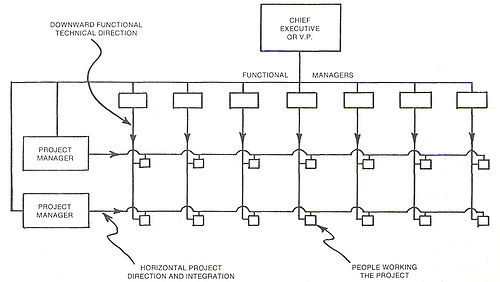
Commitment refers to the organizations recognition of the importance of a given project. Oftentimes, projects are deemed as important, based on their size and not of their significance and possible impact on the company. It may often be an issue that the functional managers are not committed enough to a project, and thus will not dedicate the proper amount of resources to the project managers to allow them to properly carry out their tasks. The size of an organization is also a major factor in this regard, as the feeling of responsibility and commitment sometimes disappear in larger organizations, in comparison to smaller ones.
The context of a project can often be an important factor to look at, when finding root causes for problems in a company. The context of a project differs alot, depending on a lot of factors, such as the size of the organization, the specialization of the project, the urgenzy, the culture etc. These are all factors which are difficult to quantitatively measure, but are very relevant and can create issues within an organization.
Complexity refers to the situations that arise when different projects or business functions interact. This oftentimes create issues and problems that are very difficult and complex to resolve. As will be mentioned later in this article, this can lead to complex and unstructured problems, for which an organization will need to use certain tools in order to solve.
Tools
Project Management Office (PMO)
As mentioned previously in this article, one of the issues that arise in organizations in relation to MPM is the allocation of resources. A reason for the conflicts that arise between projects or between PM’s and line managers can often be caused by a lack of standards for carrying out projects. The PMO is part of the organizational structure, whose job it is, to ensure that the organization can carry out projects as smooth as possible. There are three different types of PMO’s: Supportive, Controlling and Directive.
In the case of Multiple Project Management, this article will focus on the supportive and controlling PMO’s as they are deemed most relevant for this specific purpose. The directive PMO takes total control of the management of projects and thus it seems mutually exclusive with MPM[5].
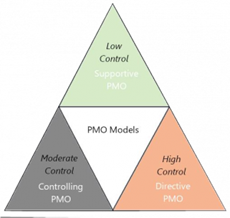
Supportive PMO
The supportive PMO is the model which exercises the least amount of control over the projects. This PMO provides/creates standards based on experience from other projects as well as provides the project with the necessary information and data they need to complete their objectives. The role for this in terms of MPM is that it provides templates and standards for the projects, which may help to decrease the likelihood of conflicts/issues in the organization. Still, this PMO does not force anything on the projects and project managers.
Controlling PMO
The controlling PMO also creates standards and templates to be used in the projects. The difference between this and the supportive PMO is that they in this case are mandatory company standards. This can help the organization create rules for carrying out projects and thus avoid confusion/conflict around resource allocation, documentation etc. This may be considered to be the most effective PMO to handle the possible issues that arise in companies with MPM. It is important to underline that the PMO is used to alleviate many other facets of Project management and the aforementioned description and recommendation is based solely on its usefulness as a tool in Multiple Project Management.
Goldratts Current Reality Tree (CRT)
One issue that many companies face, when dealing with organizational problems and issues is finding the causes of said problems. If a problem is unstructured in its nature it may be very difficult to find the proper management tool to find the root causes and solve it.
The Current Reality Tree is a tool used to structure these problems and finding the root causes, thus solving problems that were ‘’unsolvable’’ before. In relation to MPM it can help alleviate many of the problems that can arise when project managers have to manage multiple projects as mentioned previously in this article.
The approach is as follows:
1. Agree on the scope In order to solve any problem it is crucial that everyone agrees on the scope to make sure that all the information is available and that you stay on a certain path. For example, if you are within a large organization it is important to state the scope as being within the department/area that you are dealing with as the problem might become too complex if you take the organization as a whole. Identifying this will help you identify the stakeholders and people you need to include to solve the issue in a satisfying manner.
2. List the undesirable effects (UDE)
The second step is identifying what current negative impacts the problem has on the organization. This is not the same as asking what needs to be fixed, although it might sound similar.
One difference is, that you want to start with a few UDE’s, ideally 5-10 as one does not want to start complicating things too much at this early stage. Secondly you review whether or not these UDE’s are the right ones by asking two important questions.
First you need to ensure that these effects are real and not just perceived effects. Additionally it is important to make sure that these effects are caused by the problem and not by other factors as is often the case.
Secondly it is crucial that you ensure that the effects are correctly described. One needs to make sure that the severity and scope of the effect is correct, using the data and information at hand. It is usually not enough to just describe an effect in one or two sentences like ‘’Bad customer service’’. The effect needs to be detailed so it can be used effectively moving forward.
A third thing that is important is to state the effects by how they are currently affecting the organization and not in terms of their solution. For example if it states ‘’We have bad customer service, because we do not train our staff sufficiently’’ a solution has already been stated, which it should not be. Rather the problem should be ‘’We have bad customer service, leaving customers frustrated and prevents us from securing additional sales from them’’.
3. Analyze cause/effect relationships
When the list of UDE’s is complete one can begin to analyze how they are correlated and if they cause each other. This can be done graphically by linking together the UDE’s that cause each other as shown below:
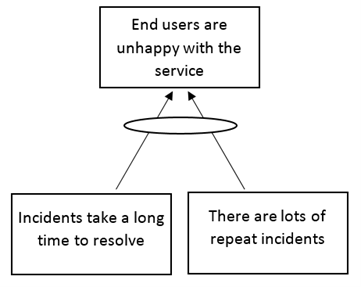
4. Tie everything together
When you have created the cause/effect relationships between different UDE’s you then tie them together to one big tree, illustrating your problem and its causes. One might find additional causes doing this process, which are then added to the tree. This process is continued until all UDE’s have been tied together in a satisfying manner. It is considered satisfactory when the tree can be read from top to bottom and the word ‘’because’’ can be stated between each UDE all the way down.
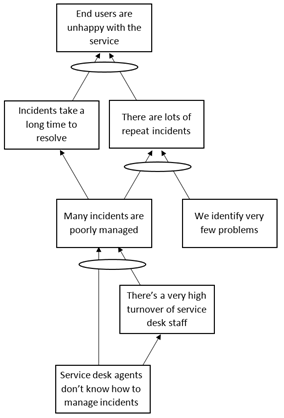
When this tree has been completed, all the UDE’s have been identified and the problem, which was previously unstructured and complex, now seem much more manageable. It is important to state that the CRT does not propose solutions, but merely provides an overview of the problem and the causes and effects thereof. After this process, management can then decide on how to solve the root causes and the problem itself.
Real world use
This chapter seeks to provide some practical examples of the aforementioned tools to be used. The purpose of this is to provide the reader with some inspiration as to how one might manage MPM in different settings. This is by no means a complete list of the usages of each tool.
PMO
In China the state still controls the real estate market and who is allowed to enter it. They have allowed for a number of large companies to compete in the fiercely competitive market. Construction companies are largely project-driven and often have to deal with managers managing several projects at once. This naturally means that these companies are bound to run into the issues and hurdles that managing multiple projects can present as mentioned earlier in this article.
Most of these companies are organized as a matrix-type organization.
This means that they have run into the typical issues which can arise from this sort of organization. The project managers are under pressure to finish their projects and thus use the organizations intellectual resources without giving much thought to the actual resource capacity and whether or not they are damaging the other functions of the company. It is believed that this problem arises as there is often no direct management in charge of making sure that these matrices function, meaning that they lack a central authority to manage the structure so these issues do not arise.
In this specific case they chose to implement the Project Management Office in order to control their projects and make sure that everything was under control and in order. They used Controlling PMO’s to align the resources and management within the companies to their respective strategic values and goals. In concrete terms, they found a number of different benefits from implementing PMO’s. They found that the project managers are more easily guided towards implementing the project in accordance with company strategy. They also experienced a larger degree of knowledge-sharing and learning by experience. This happened as there was now a central organ that monitored and controlled the projects within the organization. As the information exchange between projects and managers increased they were also able to improve the relationships between functional managers and projects managers as their values were easier to align. Projects also became easier to track for upper management as all information was now available and standardized for the different projects.[9]
Goldratts Current Reality Tree (CRT)
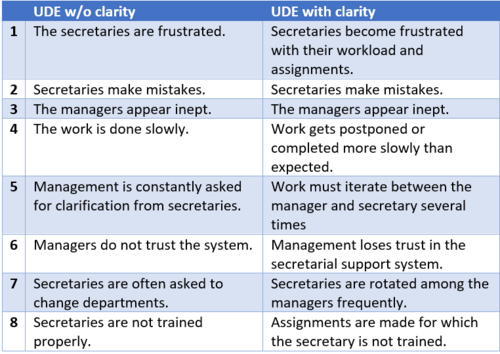
As mentioned previously in this article, CRT is a way of structuring unstructured problems in order to properly solve them. A practical example of usage of the CRT is in the company Acme (not actual company name) who has a problem regarding their secretaries. The company employs 16 secretaries in total, to service their different corporate offices. These secretaries are administered centrally in the organization. The general problem they are facing is that the secretaries are feeling like their workload is much too big and they find it difficult to finish their tasks on time as well as being assigned to tasks which they do not feel properly equipped and trained for. On the other hand, management is frustrated by the slow work processes of the secretaries and always having to wait for them.
To solve this problem, they follow the steps mentioned previously in this article. The entirety of the study can be read in this paper [10] . Here is a brief summary of their work and findings. Initially they map out their UDE’s and then test them for clarity, meaning that they properly explain each UDE as seen below:
From the right column it is evident that some of the initial UDE’s needed clarification in order to build a solid basis on which to continue the process of solving their problems.
From this step Acme then analyzed the causes and effects of the UDE’s and found that both 2 and 3, and 2 and 8 seem related. Using this knowledge they investigated which UDE were causes and which were effects. They continue this work according to the aforementioned CRT structure and end up with a complete mapping of the organizations problem as seen in Figure 7.
This is one practical example of how a mapped out CRT can look when all avenues of the problem and caused have been analyzed. Although it might look complex, this can be used by management to then make informed decisions on how to solve their problem leaving no stone unturned and without causing other problems with their solution(s).
Conclusion
Multiple Project Management is a term which covers many different aspects of both project and portfolio management. MPM in itself does not have benefits, limitations or downsides, it is merely a branch of organizational management, which may be used in project-based businesses.
As outlined previously in this article, there are many different tools to use when wanting to improve MPM, in this case PMO and CRT were highlighted as they are some of the more essential tools from which to build an effective MPM upon.
There are many issues that can arise, when project managers manage several projects, with limited resources and little to no standards. Using the tools from this article, most organizations should be able to arrive at a organizational structure, which prevents many negative incidents and a tool for struturing and dealing with the issues that may arise.
Multi project management is its own genre and it should be treated as such, as many organizations tend to look exclusively at project management techniques, when actually these might not take into account the same elements, that MPM-tools do.
Bibliography
Management of multiple simultaneous projects: a state-of-the-art review
This study provides the essential classifications of the MPM and provides a thorough inside into the elementens that the MPM constist of, as well as the potential issues that may arise. Furthermore it explains where it is most appropriate to use MPM to reduce many different types of issues and conflicts wihtin an organization.
Licht T., Schmidt L., Schlick C.M., Dohmen L., Luczak H. (2007) Simulation-based Multiple Project Management in Engineering Design.
This paper provides an approach for companies to use when handling multiple projects. It is carried out using simulation and illustrates how MPM has learned from the common shortcomings and pitfalls of regular project management.
Tamara Tsaturyan, Ralf Müller,Integration and governance of multiple project management offices (PMOs) at large organizations, International Journal of Project Management, Volume 33, Issue 5,2015,Pages 1098-1110
This paper explains in-depth how PMO's can be used at project-based organizations. It goes into greater detail than this artice and can be used as an inspiration/manual for incroporating PMO(s) into a company or organization which lack a systematic MPM-tool.
References
- ↑ 'Patanakul, P. (2010). Key drivers to the effectiveness in managing multiple projects: an empirical investigation in an IT organization of a large financial institution.
- ↑ Future of Product Development - Proceedings of the 17th Cirp Design Conference — 2007, pp. 543-554
- ↑ Management of multiple simultaneous projects: a state-of-the-art review
- ↑ https://www.pmi.org/learning/library/matrix-organization-structure-reason-evolution-1837
- ↑ Project Management Institute. (2017). A guide to the Project Management Body of Knowledge (PMBOK guide) (6th ed.). Project Management Institute. p.48
- ↑ http://dar-me.com/?page_id=13122
- ↑ https://www.optimalservicemanagement.com/blog/theory-of-constraints-using-a-current-reality-tree/
- ↑ https://www.optimalservicemanagement.com/blog/theory-of-constraints-using-a-current-reality-tree/
- ↑ Multiple project management system of real estate enterprises, 2011 International Conference on Electric Technology and Civil Engineering, ICETCE 2011 - Proceedings, art. no. 5776210, pp. 1360-1362
- ↑ Walker, Edward & Cox, James. (2006). Addressing ill-structured problems using Goldratt's thinking processes: A white collar example. Management Decision. 44. 137-154.
